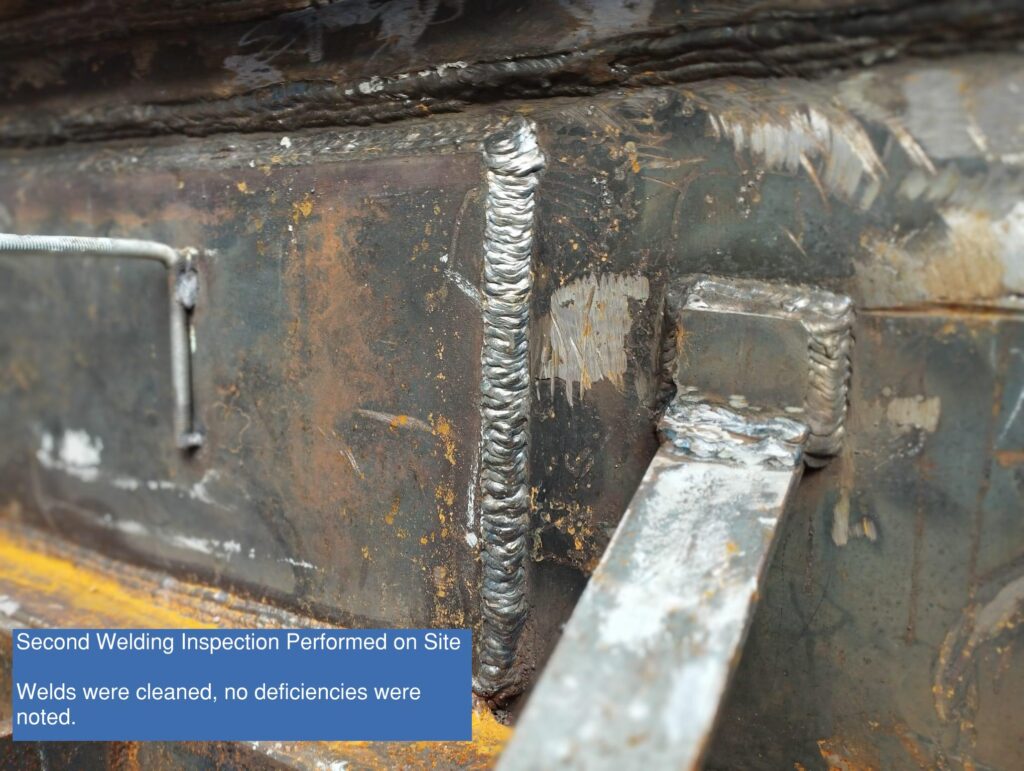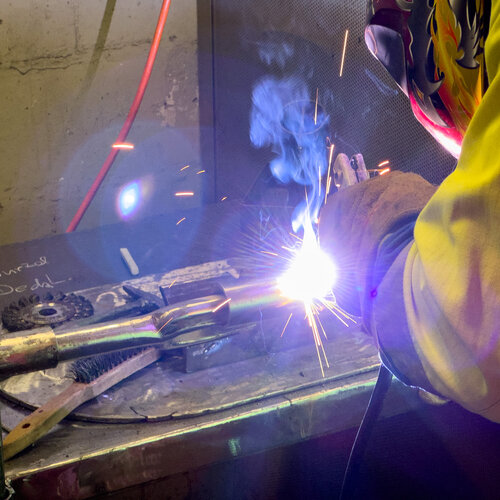Welding Inspection Racine: Making Sure Accuracy and Dependability in Every Weld
Welding Inspection Racine: Making Sure Accuracy and Dependability in Every Weld
Blog Article
Innovative Approaches to Fillet Weld Examination and Screening: Enhancing Weld Top Quality and Conformity Criteria
In the world of welding, the top quality and stability of fillet welds play a crucial function in ensuring the architectural sturdiness and integrity of different industrial parts. With the constant drive for improved efficiency and compliance with rigorous standards, the exploration of innovative strategies to fillet weld evaluation and testing has actually ended up being critical. As industries advance, the typical approaches might no longer suffice in fulfilling the demands of modern welding applications. By embracing cutting-edge innovations and techniques, a brand-new horizon of possibilities arises in the realm of weld quality evaluation and adherence to compliance requirements.
Advanced Non-Destructive Testing Methods
Using cutting edge innovations, advanced non-destructive screening techniques play an essential function in ensuring the integrity and top quality of fillet welds. These approaches, such as phased array ultrasonic testing (PAUT) and magnetic bit screening (MPT), offer in-depth insights right into the weld's interior structure without triggering any damage to the product. PAUT, for instance, utilizes numerous ultrasonic aspects to inspect the weld from numerous angles, giving a detailed visualization of potential issues like absence of blend or splits.
In A Similar Way, MPT is effective in identifying surface-breaking flaws by applying an electromagnetic field and iron fragments to the weld area. This approach is particularly valuable for identifying stoppages that may endanger the weld's strength. By utilizing these advanced non-destructive screening methods, weld assessors can accurately analyze the top quality of fillet welds, ensuring conformity with sector criteria and laws. The capacity to find imperfections at an early stage not only boosts weld top quality however additionally avoids costly rework or failures in structural honesty, highlighting the importance of these innovative screening methods in welding inspections.
Robotics and Automation in Examination
The assimilation of robotics and automation has reinvented the inspection procedure for fillet welds, boosting performance and accuracy in top quality assessment. Robotics provide precise control and repeatability in evaluating welds, making sure constant and dependable outcomes. Automated systems can be configured to comply with specific assessment courses, making sure extensive protection of welds and minimizing the risk of human mistake.
Robotic evaluation systems equipped with advanced sensors can detect and determine weld features with high precision, offering detailed data for evaluation. These systems can determine problems such as fractures, lack of fusion, and porosity, enabling prompt restorative actions to be taken. In addition, robotics and automation permit real-time information collection and evaluation, giving prompt comments to drivers and promoting quick decision-making procedures.
Furthermore, the usage of robotics and automation in fillet weld examination enhances overall productivity by decreasing evaluation times and raising assessment throughput. By improving the assessment procedure, suppliers can ensure weld quality and compliance standards are fulfilled effectively, eventually leading to cost financial savings and improved product high quality.
Using Artificial Knowledge for Evaluation
Man-made intelligence plays a critical role in boosting the performance and precision of evaluation in fillet weld examination procedures. By harnessing the power of AI, inspectors can enhance the analysis of weld top quality and conformity criteria, causing much more specific and reputable outcomes. AI formulas can quickly process huge amounts of data from weld evaluations, discovering flaws or disparities that might be challenging to identify with the nude eye. This innovative innovation makes it possible for real-time monitoring of weld top quality, permitting immediate rehabilitative activities to be taken if any problems are discovered.
Furthermore, AI systems can pick up from previous assessment information, continuously improving their capacity to determine potential issues and deviations in fillet welds. This adaptive understanding capability boosts the overall quality control procedure, minimizing the probability of human mistake and guaranteeing that welds meet the needed standards. By incorporating fabricated intelligence right into fillet weld analysis, markets can accomplish higher levels of performance, uniformity, and compliance in their inspection practices.
Portable Equipment for On-Site Evaluation
 Enhancing area assessment effectiveness, the fostering of portable devices reinvents on-site assessment processes for fillet welds. These tools use flexibility and benefit, enabling examiners to conduct detailed assessments in various locations, including difficult or remote settings. Mobile tools such as ultrasonic screening gadgets, magnetic bit assessment tools, and digital radiography systems give real-time data and high-resolution imaging capabilities, allowing fast decision-making and instant responses on weld quality.
Enhancing area assessment effectiveness, the fostering of portable devices reinvents on-site assessment processes for fillet welds. These tools use flexibility and benefit, enabling examiners to conduct detailed assessments in various locations, including difficult or remote settings. Mobile tools such as ultrasonic screening gadgets, magnetic bit assessment tools, and digital radiography systems give real-time data and high-resolution imaging capabilities, allowing fast decision-making and instant responses on weld quality.One significant benefit of portable tools is their capability to enhance evaluation treatments, minimizing downtime and boosting total productivity. Assessors can easily transport these tools to various task websites, getting rid of the requirement for carrying heavy machinery or parts to off-site facilities. Additionally, the transportability of these tools promotes cost-effectiveness by decreasing transportation costs check my source and accelerating evaluation timelines.
Additionally, the usage of mobile tools for on-site examination promotes aggressive quality assurance procedures, as inspectors can quickly determine and deal with any kind of possible welding problems or discrepancies. By integrating these cutting-edge innovations right into on-site inspection techniques, welding professionals can ensure conformity with industry requirements and enhance weld high quality, ultimately causing boosted architectural stability and security in different welding applications.
Integration of Data Management Solution
Having actually maximized on-site examination processes through the use of portable tools, the following phase entails the smooth combination of data monitoring systems to further enhance performance and data evaluation abilities in fillet weld assessment and screening. Welding Inspection Racine. By integrating information monitoring systems into the examination process, organizations can simplify data collection, storage space, and evaluation. This combination permits real-time surveillance of weld high quality, immediate identification of issues, and prompt decision-making to fix any issues that may find here arise throughout the evaluation procedure
The combination of information management systems makes it possible for seamless interaction in between different stakeholders involved in the assessment process, cultivating collaboration and enhancing general high quality control steps. Eventually, the combination of data management systems offers to elevate the criteria of fillet weld assessment and screening, making sure conformity with market guidelines and enhancing weld high quality.
Conclusion
In conclusion, cutting-edge strategies to fillet weld assessment and screening have substantially improved weld quality and conformity criteria. Advanced non-destructive screening methods, robotics, automation, artificial knowledge, mobile devices, and information management systems have revolutionized the means weld evaluations are performed. By using these technologies, markets can make sure that click here now welds fulfill the needed high quality criteria and laws, eventually boosting overall effectiveness and safety and security in welding processes.

By utilizing these sophisticated non-destructive screening techniques, weld examiners can precisely examine the high quality of fillet welds, making sure compliance with industry standards and guidelines. Mobile tools such as ultrasonic testing devices, magnetic bit evaluation equipment, and digital radiography systems supply real-time data and high-resolution imaging capacities, making it possible for quick decision-making and instant feedback on weld quality.
Having maximized on-site assessment procedures with the utilization of portable tools, the next stage entails the smooth assimilation of data management systems to further enhance efficiency and information analysis capacities in fillet weld inspection and screening (Welding Inspection Racine). Ultimately, the combination of data management systems serves to boost the criteria of fillet weld examination and screening, ensuring conformity with industry guidelines and boosting weld top quality
 In final thought, cutting-edge strategies to fillet weld inspection and screening have actually dramatically enhanced weld top quality and compliance requirements.
In final thought, cutting-edge strategies to fillet weld inspection and screening have actually dramatically enhanced weld top quality and compliance requirements.Report this page